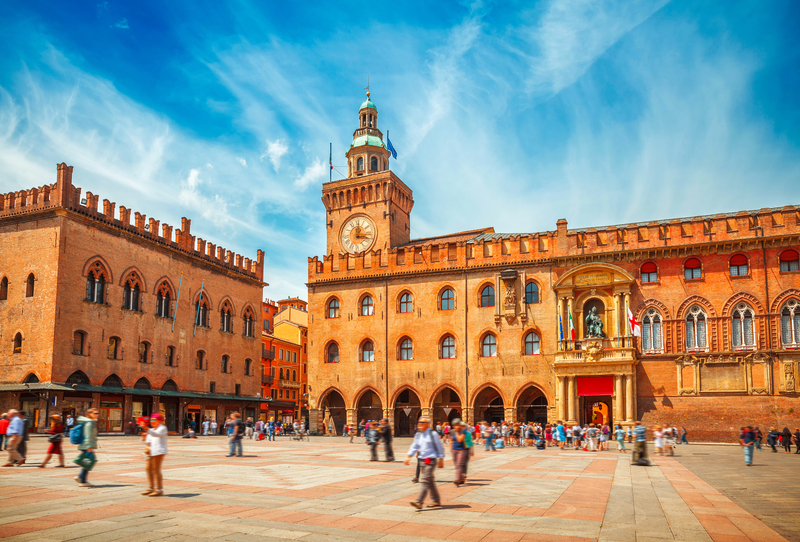Piazza della Signoria, Piazza del Plebiscito, Piazza Navona, Piazza San Marco: listing few among the most famous piazze in Italy would be enough to understand the deep meaning of a place that most Italians consider like home. In fact, the piazza is mainly a second home where – besides ages, genders, social classes – everybody is welcomed and feels comfortable.
Called the ‘salotto a cielo aperto’ of a city or town, this “open air living room” allow people to speak aloud while, sitting on the ground, they enjoy to talk, think, read, or just look around. The idea of the piazza was introduced in Italy in the Middle Ages, usually as a square of the Cathedral or a space in front of the headquarters of a civil authority. While these two aspects differentiated their use and architecture, sometimes the two types merged in the arcades on the church sides while the square developed according to an urban purpose. Together with these two types, a third model for the piazza also existed: when the market opened in the area, it became a place where people used to gather, in an established day, to buy the best products from local farmers.
But, when did the Italian piazza become the core of the town, as we know today? As soon as Bernini started working on the most stunning architectural masterpiece in history, Saint Peter Square, the idea of piazza changed. The principle was to combine circles and to form an ellipse, which reminded the antique colosseum, and the square was the result of different individual contributions and a collective construction.
Since it may be impossible to go through thousands of historical Italian piazze, as well as it would be not fair to distinguish them with a scale of values, we will go through a few of them, as beautiful and unique as the most famous ones.
Piazza Maggiore, Bologna
Founded as “platea communis” where people gathered during the daily market, it is considered one of the most relevant urban projects in the Middle Ages. Today’s piazza is the result of several alterations: built to establish a physical and a symbolic core, it still has the same function, with local residents using the statue of Neptune, one of the city’s symbol, as meeting point. Piazza Maggiore is surrounded by the most important buildings of the medieval city, like the Palazzo del Podestà, from 1200s, and the Palazzo Re Enzo.
Piazza Duomo, Lecce
One of the major attractions of the city, it was built in 1144, and rebuilt in 1230. Once restored in the years 1659-70, Giuseppe Zimbalo also built the 70 m-high bell tower. The baroque style characterizes the atrium leading to the entrance of the Cathedral, the seminary and the Palazzo Vescovile. Unlike most piazzas we find around Italy, Piazza Duomo is enclosed on three sides with a narrow, north side entrance off the main street. The side view of the Duomo, also by Zimballo, is a triumphal arch completed in honour of Saint Orontius.
Piazza dei Miracoli, Pisa
The piazza is not located in the center of the city, as usual, but placed in the north-west of the fortified wall, almost out of town. According to experts, since the Etruscans’ era, three structures in the piazza were considered important to religious life, symbolizing the main stages of a human’s life: the Baptistry represents birth, the Cathedral of Santa Maria Assunta life and the graveyard, of course, alludes to death. While the square took form in 1064 with the creation of the Cathedral dedicated to Santa Maria Assunta, the cathedral symbolizes the maximum expression of Pisan Romanesque, also influenced by the Arab world.
Piazza del Popolo, Ascoli Piceno.
Seen as the best example of elegance, harmony, and proportion, the architecture and the portico design, as well as the stunning paving and the perspective are the main elements of the piazza, surrounded by elegant Renaissance-style buildings bearing lively colonnades and decorations. It is still the most vibrant place of this town in the Marche region, dominated by the Palazzo dei Capitani del Popolo, with a 13th century tower and a massive portal dating from 1546.
Piazzas in Italy are mostly connected to the mild climate of the Mediterranean and would be unthinkable in a country too hot or too cold. Nevertheless, what did and still make them unique in the Italian context is their history and their architecture, whose study allows to understand not only their urban function, but also their social and religious purposes which have been kept over time.































